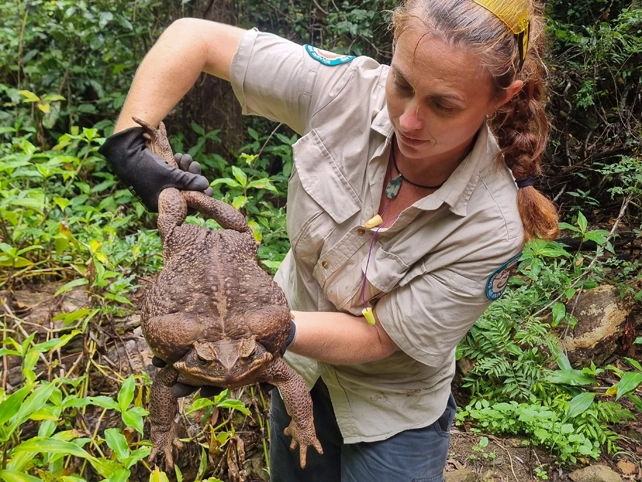Rangers in Australia have killed an invasive large cane toad that was found in a coastal park. The toad was described as being as long as a human arm and weighing 2.7 kilograms (6 pounds). The animal was captured and humanely put to sleep. Cane toads were brought to Queensland in the past as an attempt to control the cane beetle, but they had severe impacts on other local wildlife.
ScienceAlert mentioned that the discovery was made when a snake was spotted crossing a track, causing wildlife workers to stop their vehicle in Queensland's Conway National Park. Ranger Kylee Gray, who made the discovery, said she was surprised by the size and weight of the toad and explained that a cane toad of that size would eat anything it could fit in its mouth, including insects, reptiles, and small mammals.
Enormous Toad
The toad's weight of 2.7 kg is close to that of a newborn baby, making it possibly a record-breaking specimen. The Queensland Department of Environment and Science referred to it as a "monster," and it may be kept at the Queensland Museum. The rangers believe that the toad was likely a female due to its size.
The cane toad, also known as the giant neotropical toad, is a poisonous warty large amphibian that is native to South and Central America. It is considered as one of the worst invasive species globally. They were introduced to other countries to control agricultural pests, but they were not effective at controlling insects; instead, they were very successful in reproducing and spreading, as per the National Invasive Species Information Center (NISIC).
Their diet mainly includes insects, but they can also consume other small animals, such as birds, reptiles, amphibians, and small mammals. Back in 1935, at the request of sugarcane plantation owners, around 2,400 cane toads were introduced to North Queensland to control the cane beetles which were damaging sugarcane crops by eating the roots. They had no natural predators in Australia. Due to their ability to reproduce easily and eat almost anything, they spread rapidly and widely.

invasive "monster" cane toad
ALSO READ: Monitor Lizards are "Ecosystem Engineers" According to Research
Toxic and Invasive
The current population of cane toads in Australia is in the millions and their range has expanded to cover thousands of square miles in northeastern Australia. Cane toads have also spread to other parts of the world such as Florida, Hawaii, Guam, the Philippines, the Caribbean islands, the western Pacific islands, Papua New Guinea, and other locations. They are toxic and can harm both domestic pets and native species if they are bitten, licked, or eaten. They also outcompete native species for resources such as food and breeding habitats.
Cane toads produce a milky poison from the parotoid glands located behind their shoulders called bufotoxin. This toxin contains various chemicals, such as bufagin which affects the heart, and bufotenine, which is a hallucinogen, as stated by the National Geographic report.
They breed all year round and lay a large number of eggs, between 8,000 to 30,000 at a time, in strings in freshwater. Both their eggs and tadpoles are also toxic. They are highly adaptable and can be found in a variety of environments, including urban and agricultural areas, dunes, coastal grasslands, and the edges of rainforests and mangrove swamps.
RELATED ARTICLE: Lack of Natural Predators Turns Overly Poisonous Cane Toads Into Cannibals, Become Invasive Species
Check out more news and information on Frogs and Invasive Species in Science Times.














